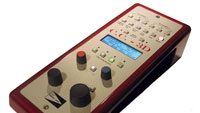Camera Corps to show universal 3-D/2-D remote camera control

At the 2011 NAB Show, Camera Corps will demonstrate its CC-3D Universal RCP controlling six cameras of different makes and models from a single panel.
Up to two stereoscopic rigs can be controlled on a paired-camera basis to maintain predetermined adjustment offsets between left and right cameras, or as individual cameras if preferred. The panel facilitates fast and easy operation during remote broadcasts as well as for live stage or studio events.
On the top row of the CC-3D Universal RCP are six channel-selection pushbuttons, assignable to each camera. Fixed-operation buttons are positioned on the next row, each with a specific function and always active regardless of which menu is selected. Below this are two selector buttons, which are used to navigate through the various menu screens. Four function-adjustment buttons below the menu screen perform actions on currently displayed parameters.
A full set of engineering presets is accessible and, once set, can be password-protected to prevent unauthorized changes. Cue/tally information for all six channels can be accommodated, and the color of the channel-select buttons changes from green to red when a cue/tally is active. Cue/tally information is transmitted to any pan/tilt/zoom/focus joystick controllers being used and can be forwarded to the camera. Remote channel selection and remote monitor switching can also be performed.
The Camera Corps data system uses modems to convert the digital control signals into audio-style tone signals before transmission. This has many advantages compared with conventional high-bit-rate digital data control, according to the company, including practically unlimited distance as well as easy transmission over RF links and telephone lines. Standard audio cables or Cat 5 data cable can be used for control data transmission. The data is simply paralleled using XLR3 splitters for transmission to multiple cameras/heads.
The CC-3D Universal RCP can be operated stand-alone or fully integrated with other Camera Corps control equipment and is available in rack-mounted or desktop versions. The panel operates from 9VDC to 18VDC power and consumes approximately 1.5W.
The professional video industry's #1 source for news, trends and product and tech information. Sign up below.
